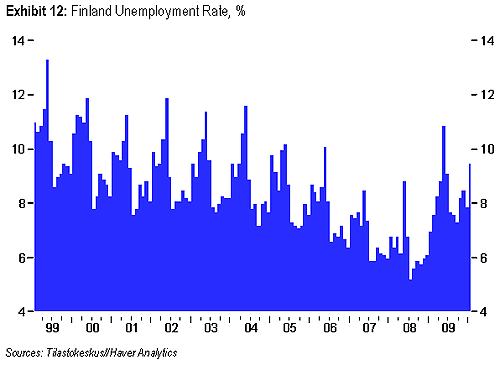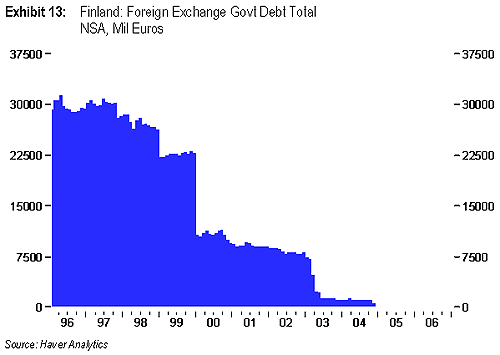

 |
 |
|||||||
| | ||||||||
|
|

The Sovereign Challenge: Does Finland Provide a Roadmap for Sustainable Economic Recovery? By Scott B. MacDonald In recent months there has been considerable attention given to the trials and tribulations of Greece and, to a lesser extent, Portugal and Spain. Indeed, sovereign risk has returned with a vengeance as a factor in international markets. The combination of bank failures and build up in debt related to the transfer of risk from the private to the public sector and a wide range of stimulus packages has created uncertainty over the ability of OECD governments to return to sustainable growth in the near term. Despite this, we have been down this path before. The experience of Finland in the late 1990s offers some important lessons for the present. Finland underwent a profound economic change in the 1980s. The Nordic country of 5 million people moved to upgrade its financial system by a process of deregulation, introducing new financial products and eliminating currency controls. This facilitated access to foreign credit for Finnish banks, corporations and citizens. At the same time, Finland benefited from strong economic growth in the rest of Europe, which boosted its exports. With a strong head of economic growth and easy capital, many Finnish companies borrowed capital to expand their operations. Finland's economy enjoyed strong economic growth through much of the 1980s, but this concealed a number of problems.
The catalyst for Finland's depression was the implosion of the Soviet Union in 1991. Finland's economy was closely linked to the Soviet Union through trade. When its neighbor ceased to exist and fragmented into a number of new nations, Finland's exports to the Soviet Union went from around 20 percent of its economy to virtually zero in a very short period of time. In addition, Western European economic growth cooled, international interest rates went up, and the Finnish markka, its national currency, depreciated - something that inadvertently hurt corporate borrowers. Private sector debt shot up from around 225 percent in 1987 to over 350 percent in 1990-1993. When the economy tumbled and the currency depreciated, companies defaulted on their debt and the crisis spun into the country's banks. In 1991 and 1992, Finland's banking system collapsed. This situation was further aggravated by the Finnish central bank's decision to raise interest rates, which only further caused liquidity in the economy to evaporate. Real GDP shifted from 5.6 percent real GDP in 1989 to flat in 1990 and then three consecutive years of contraction. Rounding out the picture of economic carnage was the spiking of unemployment from under 3 percent in 1990 to 18 percent over the next three years (see table below). It would not be until the end of the decade that unemployment would head down to more manageable levels. 
While the Finnish government initially struggled with the situation and made some missteps (such as raising interest rates), it did adopt a pro-active stance on the banks and economic restructuring. It was facing cumulative credit losses of Finnish banks equal to 15 percent of GDP, a wave of corporate bankruptcies, and massive household debt problems. At the same time, house prices fell by 50 percent and the Helsinki stock market index plunged by 70 percent. By most indicators this was the worst economic crisis since the Great Depression in the 1930s, which Finland actually weathered comparatively better than other countries. As the Finnish government intervened in the banking sector and provided support for some of the corporate sector, the country's debt burden rose and there were concerns the country might have to go to the International Monetary Fund for assistance. Finland, however, refused to go to the International Monetary Fund. Instead it let the markka float, which helped exports. The markka was ultimately devalued by 40 percent. Additionally, domestic interest rates were cut, the government assumed control of the country's largest savings bank group, created a separate problem loan liquidation company, sold healthy assets to other banks, and provided equity loans to banks to help recapitalization. It also forced a number of bank mergers. The government also legally went after failed bank managers, which produced long trials and few convictions. Despite the tough medicine in this process, Finnish society largely supported the government measures to restructure the economy. 
The Finnish government's measures resulted in a lengthy period of deleveraging. According to a recent McKinsey study, Finland's deleveraging commenced in 1991 and lasted until 19981. During that period total debt declined by almost a third to 73 percent of GDP. It continued to fall in the first decade of the 21st century (see table above). It is important to underscore that this deleveraging process was accompanied by an eventual return to economic growth (the average annual real GDP growth was 4.7 percent in 1994-2000 and 3.5 percent in 2001-2007), a revival of the stock market (the Hex-index quadrupled in 1993-1998), and a return to fiscal health. Finland's banks also recovered, without any new major crisis. 1McKinsey Global Institute, Debt and Deleveraging: The Global Credit Bubble and Its Economic Consequences, January 2010. Finland's deleveraging was a long and painful process, but ultimately successful. It came in two parts, 1991-1994 and 1994-1998. It was only in the second stage that credit returned and even then it was haltingly. The real driver in helping reduce debt/GDP levels was the expansion of exports. Behind all of this, the government's policy response was critical. As the McKinsey report observed of the government: "It proved key to restoring confidence, reviving private investment, and generating the economic rebound that made the deleveraging process much easier in the later years." To this could be added that the Finnish government gained experience as it went along, getting a better idea of when to intervene and when to start reducing the role of the state. Finland's experience is important as it demonstrates how an OECD country got into a severe financially-related crisis - and what it did to find a path out. This has a context to the current deep problems confronting many OECD nations. Indeed, Finland should point a way for Greece, but unlike the Nordic country there are serious questions over political will in Athens to adhere to the right policies. Along these lines, Ireland has most likely put itself down a similar path to Finland in the 1990s, with a well-defined objective of cleaning up the financial mess and restoring competitiveness, with a begrudging supportive societal consensus. Finland's experience, however, also has relevance to the larger OECD countries for many of the same reasons - deleveraging takes time, good policy decisions always matter, and a broad societal consensus is essential in tackling problems of size and scope. It can be argued in the U.S. the idea that deleveraging takes time and can be painful has not sunk in, spending is not being reigned in, and a societal consensus on these matters is lagging. That understanding is likely to prove essential to spell out a path for strong and sustainable recovery. While the information and opinions contained within have been compiled from sources believed to be reliable, KWR does not represent that it is accurate or complete and it should be relied on as such. Accordingly, nothing in this article shall be construed as offering a guarantee of the accuracy or completeness of the information contained herein, or as an offer or solicitation with respect to the purchase or sale of any security. All opinions and estimates are subject to change without notice. KWR staff, consultants and contributors to the KWR International Advisor may at any time have a long or short position in any security or option mentioned.
KWR International Advisor Editor: Dr. Scott B. MacDonald, Sr. Consultant Deputy Editors: Dr. Jonathan Lemco, Director and Sr. Consultant and Robert Windorf, Senior Consultant Associate Editor: Darin Feldman Publisher: Keith W. Rabin, President To obtain your free subscription to the KWR International Advisor, Website content © KWR International |